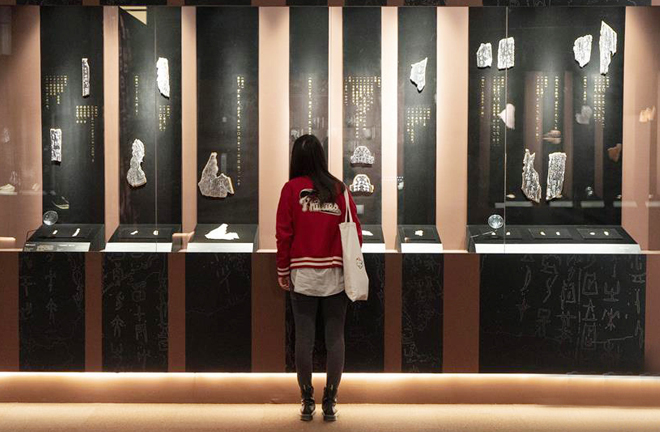Oracle bone study going strong since discovery 120 years ago

Visitor views exhibits at an exhibition to commemorate the 120th anniversary of the discovery of oracle bone inscriptions at the National Museum of China. Photo: XINHUA
“I’m here,” said Luo Lin, in her 80s, once again returning to Xiaotun Village, Anyang City, Henan Province. It is Oct. 20, 2019, and she feels deep nostalgia. Introducing herself, she says, “I am the seventh granddaughter of Luo Zhenyu.” Luo Zhenyu was one of the four master scholars of oracle bone study. He found evidence that oracle bones were unearthed in Xiaotun Village, Anyang while proposing Anyang to be the capital of the Shang Dynasty, referring to the Yin Ruins in the historical records since the Western Han Dynasty. Oracle bones excavated in the village are relics of the Shang Dynasty, and they have played an important role in later oracle bone studies. For Luo Lin, this place of stories is a place of warmth.
“We excavated oracle bones right here,” said Cao Dingyun, a researcher at the Institute of Archaeology at the Chinese Academy of Social Sciences (CASS), as he ran like a child to take pictures next to the signboard of the excavation site. In 1973, the Anyang Working Team organized by his institute conducted two excavations in the southern part of Xiaotun Village and discovered a total of 7,150 pieces of shell and bone script.
On the evening of Oct. 17, 2019, Yinxu Archaeology and Oracle Bone Research was published in Anyang. Its author Liu Yiman is an 80-year-old researcher at the Institute of Archaeology at CASS. Liu participated in the excavation work at the southern part of Xiaotun Village in 1973 and then at the eastern part of Huayuan Village in 1991. After retirement, she spent six years on the 700,000-character work. Anyang, lingering in the hearts of archaeologists like Cao and Liu, is a holy place.
Richard H. Sears is a 70-year-old American, but Chinese people prefer calling him “Uncle Hanzi” (“Uncle Chinese Character”). Though he majored in physics, he established a website concerning the origins of Chinese characters, so that people all over the world could have free access to the resource. He also opened a WeChat public account where he shared his analysis of patterns of Chinese characters in English and Chinese languages. Anyang, as the birthplace of oracle bone studies, is a place that people who love Chinese characters yearn to see.
These people recently gathered in Anyang to commemorate the 120th anniversary of the discovery of oracle bone inscriptions.
To date, scholars have unearthed about 160,000 pieces of oracle bones and identified more than 4,500 characters. According to incomplete statistics, about 280 books and more than 30,000 papers concerning oracle bone inscriptions have been published. In 2006, the Yin Ruins in Anyang was placed on the World Heritage List. In 2017, oracle bone inscriptions were included in the UNESCO Memory of the World Register, winning worldwide recognition and respect. Behind this, generations of scholars have made tremendous contributions to their collection, compilation, research and protection.
The International Academic Conference to Commemorate the 120th Anniversary of The Discovery of Oracle Bones received nearly 70 papers covering a wide range of oracle bone research, including the interpretation of oracle bone scripts, the relationship between oracle bones and the history of the Shang Dynasty and their classification, dating, compilation, identification and technological application. These papers reflect the current circumstances and quality of oracle bone research.
At the recent forum themed on the cultural dissemination and development of oracle bone study, Chen Nan, a professor from the Academy of Fine Arts at Tsinghua University and the executive deputy director of the Research Center of Art of Ancient Chinese Characters spoke enthusiastically about the oracle bone character database and emoticons published in 2017. “Examining the expression大家好 (dajiahao) which means ‘everyone is fine,’ 大 looks like a man, and好 can be divided into a woman on the left and a son on the right. 家 represents a pig under an eave. Representing this emoticon, the three family members and a pig all gather under an eave, which shows the creativity involved in expressing ‘Everyone is fine,’” Chen said, noting that seven sets of oracle script emoticons have been released. Hundreds of thousands of phone users have downloaded them for free.
Written words symbolize the birth of civilization. They are the first breath of cultural circulation. Oracle bone scripts, with thousands of years of inheritance, are one of the sources of our nation’s cultural self-confidence. More people are working hard on the questions of how to bridge the gap between oracle bone study and cultural exchange and how to realize the true value of oracle bones by displaying them in museums.
This article was translated from Guangming Daily.
edited by MA YUHONG
